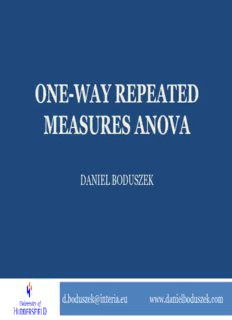
One-way repeated measures ANOVA PDF
Preview One-way repeated measures ANOVA
ONE-WAY REPEATED MEASURES ANOVA DANIEL BODUSZEK [email protected] www.danielboduszek.com Presentation Outline Introduction Assumptions SPSS procedure Presenting results Introduction One-way repeated measures ANOVA - each subject is exposed to 3 or more conditions, or measured on the same continuous scale on three or more occasions (2 conditions = dependent t-test) Mean Intervention Mean Intervention Mean Time 1 Time 2 Time 3 Repeated Measures ANOVA ONE-WAY Repeated Measures ANOVA What do you need? One categorical IV (Time 1, Time 2, Time 3) One continuous DV (scores on Criminal Identity) Research Question: Is there a change in Criminal Social Identity scores for offenders across of time spent in prison? Assumptions Independence of observations – observations must not influenced by any other observation (e.g. behaviour of each member of the group influences all other group members) Normal distribution Random Sample (difficult in real-life research) Homogeneity of Variance – variability of scores for each of the groups is similar. Levene’s test for equality of variances. You want non significant result (Sign. greater than .05) SPSS procedure for One-Way repeated- measures ANOVA From the menu at the top of screen click on Analyze, then select General Linear Model, then Repeated Measures SPSS procedure for One-Way repeated- measures ANOVA In the Within Subject Factor Name box, type in a name of IV (e.g. Time) In the Number of Levels box – time periods (e.g. 3) Click Add SPSS procedure for One-Way repeated- measures ANOVA Click on Define button Select the 3 variables that represent repeated measures variable (Criminal Identity, Criminal Identity 2, Criminal Identity 3) and move them into the Within Subjects Variables box SPSS procedure for One-Way repeated- measures ANOVA Click Options, and click Descriptive Statistics, and Estimates of effect size box in Display If post-hoc tests, select IV name (Time) in the Factor and Factor Interactions section and move into the Display Means for box. Tick Compare main effect. In the Confidence interval adjustment section, select Bonferroni Continue and OK Interpretation of SPSS output Maluchly’s Test of Sphericity The sphericity assumption requires that the variance of population difference scores for any two conditions are the same as the variance of the population difference scores for any other two conditions (an assumption that is commonly violated; Sig. = .000) Mauchly's Test of Sphericityb Measure:MEASURE_1 Epsilona Approx. Chi- Greenhouse- W ithin Subjects Effect Mauchly's W Square df Sig. Geisser Huynh-Feldt Lower-bound Time .429 73.562 2 .000 .637 .642 .500 Tests the null hypothesis that the error covariance matrix of the orthonormalized transformed dependent variables is proportional to an identity matrix. a. May be used to adjust the degrees of freedom for the averaged tests of significance. Corrected tests are displayed in the Tests of W ithin-Subjects Effects table. b. Design: Intercept W ithin Subjects Design: Time There are ways to compensate for this assumption violation – multivariate statistics
Description: